This worksheet is intended for individuals with PTSD who experience hallucinations and for healthcare professionals, including therapists and counselors, to administer to their clients. It is a valuable tool, like a diary account, for clients and practitioners in managing and addressing hallucinations.

Hallucination Diary PTSD Worksheet
Use this Hallucination Diary PTSD Worksheet to help your client track and discuss their PTSD-related hallucinations and how they affect them.
Hallucination Diary PTSD Worksheet Template
Commonly asked questions
While the worksheet is primarily designed for PTSD-related hallucinations, it can be adapted for other mental health conditions where hallucinations are a symptom, such as some forms of schizophrenia. However, it may need customization to align with specific diagnostic criteria.
No, the worksheet is not a substitute for therapy. It is a supportive tool that can enhance therapy by providing structured documentation and insights into hallucinatory experiences. Individuals with PTSD should still seek professional help and therapy for comprehensive treatment.
EHR and practice management software
Get started for free
*No credit card required
Free
$0/usd
Unlimited clients
Telehealth
1GB of storage
Client portal text
Automated billing and online payments











